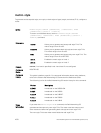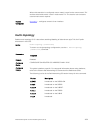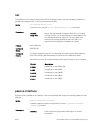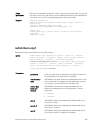metric-style
To generate and accept old-style, new-style, or both styles of type, length, and values (TLV), configure a
router.
Syntax
metric-style {narrow [transition] | transition | wide
[transition]} [level-1 | level-2]
To return to the default values, use the no metric-style {narrow
[transition] | transition | wide [transition]} [level-1 |
level-2]
command.
Parameters
narrow Allows you to generate and accept old-style TLVs. The
metric range is from 0 to 63.
transition Allows you to generate both old-style and new-style TLVs.
The metric range is from 0 to 63.
wide Allows you to generate and accept only new-style TLVs. The
metric range is from 0 to 16777215.
level-1 Enables the metric style on Level 1.
level-2 Enables the metric style on Level 2.
Defaults narrow; if no Level is specified, Level-1 and Level-2 are configured.
Command
Modes
ROUTER ISIS
Command
History
This guide is platform-specific. For command information about other platforms,
refer to the relevant Dell Networking OS Command Line Reference Guide.
The following is a list of the Dell Networking OS version history for this command.
Version Description
9.7(0.0) Introduced on the S6000-ON.
9.0.2.0 Introduced on the S6000.
8.3.19.0 Introduced on the S4820T.
8.3.11.1 Introduced on the Z9000.
8.3.12.0 Introduced on the S4810.
Usage
Information
If you enter the metric-style wide command, the Dell Networking OS
generates and accepts only new-style TLVs. The router uses less memory and
other resources rather than generating both old-style and new-style TLVs.
The new-style TLVs have wider metric fields than old-style TLVs.
1070
Intermediate System to Intermediate System (IS-IS)


















